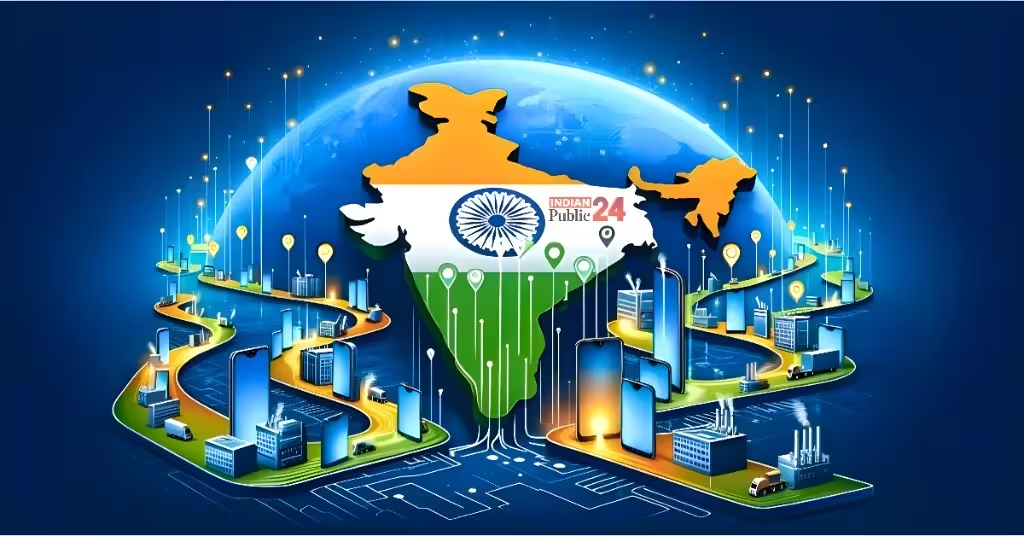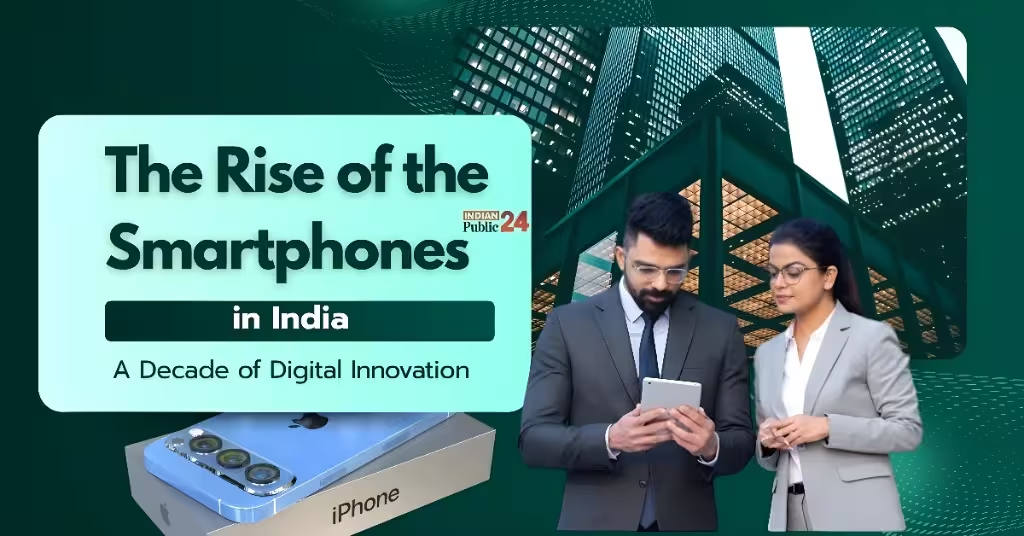Explore how smartphones transformed everyday life in India over the past 10 years. From keypad phones to 5 G-enabled devices, discover the key innovations, rising brands, and digital shifts that shaped India’s smartphone revolution.
How Smartphones Changed Everything in Just 10 Years:
You know, it seems like it was just yesterday, but about ten years ago, smartphones were not really that common in India. If someone had a smartphone, it was a big deal. To be honest, most of us had simple phones just for making calls and sending SMS messages. But then, slowly, things started to change. Before we knew it, smartphones started getting cheaper, faster, and a lot smarter. They were no longer just for talking; they became our cameras, our main source of entertainment, our banks, and, well, our mini offices. This huge change happened so fast that it’s unbelievable. India actually became one of the largest smartphone markets in the entire world. The last decade has been a really up-and-down year for phones in India.
Those Early Smartphones in India: What We Were Using Back Then
Do you remember that time, seriously? About ten years ago, the smartphone environment in India was very different. Nokia, you know, they were a really big name, but their smartphones (the Symbian ones) were not at all easy for everyone to use. Samsung also had some Android phones, but they were quite expensive. Most people, if they weren’t using basic button phones, were stuck with very basic smartphones. These early models often had small screens, or maybe very basic touchscreens, and you didn’t get a lot of apps. The internet was very slow (mostly in the early days of 2G or 3G ), and downloading anything, even a short song, took a lot of time. However, battery life was usually great, probably because the phones didn’t do much heavy work! It was just a time when a “smartphone” was starting to show what it could do.
The Big Rise of Android and Goodbye to Keypad Phones:
Now, this was a true turning point. As time went on, Android started to surge in popularity, which is Google’s operating system for smartphones. It was very easy to use, had a lot of apps (Google Play Store got huge), and a lot of different phone companies could use it. Because of Android, phone manufacturers started to really bring out much more affordable smartphones. Suddenly, people started to think, Wow, a smartphone can do so much more than my old keypad phone. Those keypad phones, which were practically royal for years, slowly started to fade away. People just wanted bigger screens, more apps, and faster internet. Android delivered all of that. This was the time when the real smartphone revolution truly started in India. It was like a huge wave, and everyone was getting attracted to smartphones.
How Budget-Friendly Smartphones Changed the Game for India:
This is where the story of India gets interesting. Many companies understood one thing very clearly. Most Indians wanted good features, but they needed them at a very low price. So, brands started making what we call “budget-friendly smartphones”. These phones were not priced too high, maybe between ₹5,000 and ₹10,000, but they had features that were previously only available on those extremely expensive phones. They came with good cameras, big screens, and could use popular apps like WhatsApp and Facebook without any hassle. You see, this made smartphones accessible to millions of people who were previously unable to afford them. These budget-friendly phones were a complete game-changer. They ensured that smartphones reached every corner of India, from big cities to small villages. Honestly, this was the key to India’s digital boom.
The Impact of 4G Network, Cameras, and Apps:
While smartphones themselves were getting better during this period, something else that was changing in the background was the advent of 4G internet. With 4G networks, internet speeds became incredibly fast, and that too at a much cheaper price. Guess what it felt like then. Suddenly, it became much easier to watch YouTube videos, make clear video calls, and use all those data-heavy apps, and that too with faster speeds.
This completely changed everything. People started using apps for everything – paying bills, ordering food, streaming movies, even learning new things. And selfie cameras became a huge craze. Earlier, front cameras were pretty useless. To be honest, the advent of 4G led to the massive use of social media platforms like Facebook and Instagram. Everyone wanted a good selfie camera. Phones started coming with better front cameras, and this whole “selfie culture” became a huge part of the way we Indians use our smartphones. This was a time when phones truly became personal and social tools for all of us.
When Chinese brands arrived, prices went down drastically:
In the mid-2010s, a whole bunch of Chinese phone brands started making their way into the Indian market. Names like Xiaomi, Realme, Vivo and Oppo came up with a very simple, but powerful idea. They were offering great features at incredibly low prices. They started offering phones with powerful processors, really good cameras and big batteries at a price much lower than what Samsung or other big international brands were selling.
So started a huge “price revolution” at the time. Other brands also had no choice but to cut their prices to stay in the game. This was fantastic for Indian buyers as they were suddenly getting a lot of features for less money. These Chinese brands, naturally, became popular very quickly, making the smartphone market in India even more competitive and giving us, the users, more choices than ever before. So you can still get the best phones at very low prices- Best phones Under ₹15000 in India (2025 Edition).
How Flagship Features Are Now in Our Mid-Range Phones
You know how it used to be. If you wanted a great camera, a super-smooth screen, or incredibly fast battery charging, you had to buy a very expensive one. What we call a “flagship” phone. Well, that whole situation has changed dramatically in the last few years. Now, many of those great features that were once limited to top-tier phones are coming to our mid-range devices (phones that cost between ₹15,000 and ₹30,000). Things like high refresh rate screens (for that silky-smooth scrolling feel), multiple cameras for different shots, super-fast charging, and even better processors- all of these are now common in these more affordable phones.
It means you don’t have to spend a lot of money just to get a great smartphone experience. I would say this is a big win for Indian consumers; we can now enjoy those premium features without spending a lot of money. You can still get the best camera phones in this midrange price, such as – OPPO A5 Pro 5G, Vivo V50 Elite Edition, and OnePlus 13s
5G and What’s Next for Smartphones in India:
Now, we are fully in the 5G era. 5G is the new big thing, giving us even faster internet speeds and almost no lag. It is a game-changer for mobile gaming, crystal-clear video calls, and connecting all kinds of new smart devices around us. 5G is spreading rapidly in India, and almost every new phone above a certain price now has 5G support built in. So, Must-Know Before Buying Your Next Smartphone. Looking ahead, phones are going to get even smarter. We may see more phones with flexible screens, devices that blend in seamlessly with our surroundings, and even more advanced AI (Artificial Intelligence) that understands us better. Smartphones will become an even bigger part of our daily lives, making everything easier and more connected. Honestly, the future of phones in India looks incredibly exciting.
Wrapping Up: How Far India’s Come in Just 10 Years

So, when we look back at the last ten years. It is quite evident that the journey of smartphones in India has been nothing short of incredible. We started with very simple button phones back then. And now, most of us have powerful, smart devices in our pockets. Affordable Android phones made them accessible to everyone. Then, 4G internet brought a surge in the popularity of apps and selfies. And after that, Chinese brands came in and made great features affordable for the common man. Now, with 5G, we are moving towards an even faster and smarter future. India has moved ahead at lightning speed in this technology race, ensuring that almost every single person has a smart device. It has truly been a journey of rapid changes and massive growth for our country.
Frequently Asked Questions (FAQs):
Q. Which brand, according to you, brought the biggest change in India’s smartphone market?
Honestly, many people would agree that Xiaomi played a massive role. They entered India with a genius strategy, offering phones with really high specifications but at unbelievably low prices. This move forced almost all other brands to rethink their pricing and the features they offered. It truly opened up the market for good-quality, affordable smartphones for millions of Indians.
Q. Are Indian phone brands still active in the smartphone market today?
Yes, some Indian brands are still around, but their share in the market has changed a lot. You know, Brands like Lava and Micromax (who even rebranded as Intex for a bit) are trying their best to make a comeback. They’re focusing on specific parts of the market or trying to offer something unique. Even though they face tough competition from global and Chinese brands, they’re definitely still present and working hard to find their own space.
Q. When did 4G internet become popular and widespread in India?
4G truly became popular and started reaching almost everyone in India around 2016-2017. This was mainly thanks to Jio’s entry into the market. Jio offered incredibly cheap data and even free voice calls, which made 4G internet super accessible and affordable for a huge number of people. It completely changed the way Indians consumed mobile data.
Q. Are older brands like Nokia still selling phones these days?
Yes, believe it or not. Nokia is still selling phones. But they’re not the market leaders like they used to be, for sure. Now, they mostly focus on Android smartphones, and they also still sell their classic feature phones. HMD Global is the company that makes Nokia-branded phones these days. While they aren’t as dominant as they once were, they still have a loyal customer base and offer reliable devices.
Q. What big things can we expect in smartphones over the next 5 years?
In the next 5 years, we can expect smartphones to get even smarter and become a bigger part of our lives. I’m talking about things like foldable screens becoming much more common and affordable. AI features are becoming much more advanced (your phone might even become your best friend). With even faster charging speeds, and maybe phones becoming truly “borderless” (no visible edges on the screen). And of course, 5G will be everywhere, enabling all kinds of new smart home and city technologies, controlled through our phones.

i’m Sanjeet Chaudhary. The founder of IndianPublic24.com, a trusted platform for the latest smartphone news and tech updates. With years of experience in mobile technology, he brings easy-to-understand insights, honest reviews, and helpful tips to readers who want to stay updated in the fast-changing world of smartphones.


One Reply to “The Rise of Smartphones in India – A Decade of Digital Innovation”